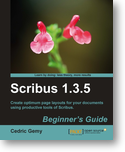Scribus 1.3.5 Beginner's Guide a review by gregp
By G. Pittman
Introduction Packt Publishing was kind enough to ask me to review Cedric Gemy's new book, just released. One of the bylines on the cover is "Learn by doing: less theory, more results." Thus, you can expect very early in the book to dive into using Scribus, and this is indeed what happens. For those that prefer this kind of approach, there is great efficiency here.
Initially, it makes sense and you will first find a nicely done and pretty thorough explanation of the layout of Scribus when it's first started. There is no doubt that there is more here than one can readily absorb, but this first chapter provides a compact reference for later use, since no time is wasted later on this material. Almost before you know it, you are off and running creating a business card. There are numerous graphics of various screen shots and dialogs, and step-by-step instructions when it comes time to do something. I had a copy of the eBook for review (a PDF), and with rather sizeable zoom, some images were a bit crowded. Downloading the various files and materials for doing the coursework is highly desirable if not essential to make your way through the exercises.
The sequence of topics seems to me quite logical, with features and types of objects introduced gradually, along with some work flow hints and suggestions that show how to speed up and improve the quality of the layout process. As a whole, the range of topics seems quite reasonable for a beginner's book. Since the book was written based on 1.3.5svn, there are some features now present in this version series not included in the book, but for a beginning book on Scribus, this is a minor issue.
Some Caveats The English is a bit rough, and while I would say that in general it is not difficult to get the gist, there are some scattered phrases and sentences that remain obscure even on rereading. Where you could see them clearly, there was a consistent use of a comma as a decimal separator in spinboxes – not something Americans are used to seeing. One of the recurring headings where some advanced actions were being suggested as extra work to try were labeled "Have a go hero", certainly an odd phraseology in English.
The graphics have no captions. Most of the time they were well-placed next to the appropriate text, but the instructions for action were almost entirely verbal in the form of lists, some rather lengthy, and often complex operations. The various materials used for the examples were certainly attractive, but perhaps more complex than necessary once you get beyond the business card.
One might argue that, since this book was for beginners, it could and should not try to be complete, but the concept and use of layers was covered rather lightly. On the other hand, some things included seemed quite advanced to me, such as using a font for the business card which has no number glyphs, and one workaround suggested was using fontforge. I also thought that having an example script using a mysql database was likely outside the interest or capability of beginners.
Summary This is a well-crafted and thought out book. I can easily envision it as the resource material for a beginner's course on Scribus, where one would have an instructor to help fill in gaps and offer explanations and other examples to help students absorb this material. Pound for pound, this is a dense book, full of insights that come from a lot of experience in using and teaching Scribus.
Greg Pittman December, 2010
